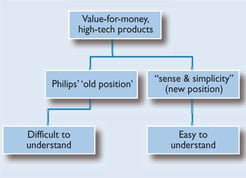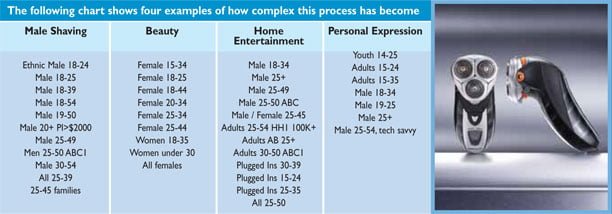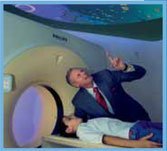Philips was established in 1891 and made lightbulbs – a simple product. Throughout the years the company increased its portfolio into technology products that became too complex for most users. When Philips realised this, it decided to make life easier and so launched a brand repositioning all about simplicity.
The term positioning refers to where products and brands are placed in a market. What is more vital is where customers see such products/brands being placed in the market. For example, customers might see products as giving ‘good value’ or ‘poor value’ for money. They may link a brand with ‘high quality’ or ‘low quality’. It is key to carry out market research to spot appropriate positions to take in the market.
An appropriate position is one that suits customers’ requirements. The term ‘repositioning’ refers to a conscious strategy to alter the site of products/brands in the market. The new ‘best’ place should be based on market research.

‘sense and simplicity‘ is the brand promise that Philips has identified through its research as the best one to take. The map below shows how the company has repositioned itself. It illustrates two key dimensions:
- simplicity
- value-for-money technology products.
You can see that Philips’ new position in its markets is based on continuing to provide value-for-money, high-tech products. In addition the new position is based on easy-to-understand goods and clear exchanges with its market.
Since the launch Philips has made great progress. This has been recorded by achieving milestones along the route. Good examples are the creation of a Simplicity Advisory Board (SAB) and the launch of a range of thriving products such as Senseo®, a coffee machine that is stylish and simple to use. The triumph of these milestones is outlined in this case study.
Creating a repositioning strategy

The stages involved in moving a product are:
- carrying out research to find out the weaknesses of the starting position
- researching a right direction to take
- making plans and taking actions to improve the position.

A problem that faced Philips in 2003 was that its media investment was rather unfocused and was spread thinly between too many different product segments. The table shows just four product areas and the target audiences for each, which were being addressed. In addition Philips’ products were marketed under lots of names, using a range of different advertising approaches. It was no wonder that there was great confusion in customers’ minds.
The challenge facing Philips, therefore, was to create a clear vision that would help the company to reposition itself and all of its related brands. A brand promise was then set out that is clear and easy to follow. The brand promise is ‘sense and simplicity’.
In the current high-tech age, consumersare faced with many hard product choices. What most of us want are clear-cut communications about the benefits that these products will provide for us. This is as true of medical professionals ordering brain scanning equipment for a hospital as it is when you or I want to buy a light bulb, electric toothbrush or cordless kettle.

This is why the brand promise ‘sense and simplicity’ is so important to Philips. This entails three main elements:
Creating consistency and direction
In order to move forward it was vital to identify the key issues. The problem facing the company was lack of constancy and direction. Resources were being spread too thinly across too many products, with developments in too many countries. Decision making within the wider Philips organisation had become patchy. This was plain to see – there were too many products, too many markets and a lack of consistency in advertising. For the consumer it was hard to tell what was and what was not a Philips product.

The first challenge was to change the Philips image. This was built around ‘sense and simplicity’. The message that Philips is getting across now is that everything it does is focused on meeting customer needs.
All that Philips does today is based on this concept. The message is spread through the organisation, making sure that all business processes are founded on ‘sense and simplicity’. Everyone who comes into contact with Philips, whether they be employees, customers, shareholders, suppliers or other stakeholders, should see this brand promise. For example, it is shown in the company logo, and all the company operations from top to bottom.
‘sense and simplicity’ is shown in all the new products that Philips develops, as well as in existing ones. When the company designs a new electric kettle, its concern is to provide a state-of-the-art, easy-to-use product. The same principle applies to medical equipment, flat screen TVs, food mixers, male and female razors and so on.
New Philips’ products are:
- advanced – based on market leading technologies
- designed around you – based on the findings of careful customer research
- easy to experience – easy to use.
Philips is also looking at all of its existing products to make sure they fit the needs of ‘sense and simplicity’.
The third key element of ‘sense and simplicity’ is communications. All Philips’ exchanges should be easy to understand. The message given is directed at the target audience and is simple to follow.

One of the key simplicity milestones has been the launch of the Simplicity Advisory Board (SAB). This is a think tank of independent experts from the fields of information technology, healthcare, fashion, design and architecture. It has been able to give an outside-in view of what simplicity means and how this can be valid across the organisation. The members of the board were chosen for their wide ranging knowledge and expertise.
Illustrating the strategy – products

We can show the new repositioning strategy by taking the example of some of the high-tech products that Philips has just worked on. A good example of this is Senseo®. Senseo® Coffee System has been developed through a partnership between Philips and Sara Lee, a Fast Moving Consumer Goods (FMCG) supplier.
The key aspects of Senseo® are:
- cool design
- easy-to-use technology
- amazing coffee.
Between 2001 and 2005 more than 10 million of these coffee machines were sold in eight countries – an impressive total. The product embodies what Philips is trying to achieve in everything it does. This is to join an exciting state-of-the-art product with simplicity. The coffee makers are combined with Douwe Egberts Senseo® coffee pods to give customers the taste they want.
Last year, Philips launched its own Simplicity Event. This provided Philips with an opportunity to share, with stakeholders, how far it has come in its commitment to ‘sense and simplicity’. Products that already deliver this promise were exhibited, together with living prototype demonstrations of how Philips envisions simplicity in the future.
Senseo® is one example of ‘sense and simplicity’ in action, other living prototypes include:
- ‘Chameleon’ – a lamp shade that changes to match any colour you show it.
- ‘In Touch’ – a mirror that transforms into a touch screen message centre, providing an alternative to leaving messages on answer phones or stuck on a fridge.
- ‘Momento’ – a glass ball, small enough to fit into the palm of your hand, offering a completely new way to share video memories. Once shaken its built in sensors will prompt the existing clip to dissolve and another to appear.
As well as supplying consumer products that are simple and easy to use, Philips also applies ‘sense and simplicity’ to all areas of its work.
For example, in the world of medical products it has created the AmbientExperience so that medical scans are less frightening for the patient. In the Ambient Experience suite, a patient can choose a relaxing visual that can be projected onto the ceiling and doctors say that this ambience helps relax the patient and makes the scanning process easier and quicker.
Philips is embedding ‘sense and simplicity’ into a wide range of high-tech medical products. ‘sense and simplicity’ is not just about making new products, however. Easy-to-understand processes are also vital. For example, Philips has invested in a ‘Welcome’ project. Philips believes that customers should have a pleasing experience from the start. Welcome therefore seeks to make sure that all Philips packaging is simple to unwrap.
Communicating “sense and simplicity”

At the heart of business success is good communication. This means sending messages from individuals or organisations to others (receivers). Good contact involves:
- communicating a brand promise, in this case ‘sense and simplicity’
- in a clear and easy to understand way
- to the right target audience
- using the right media.
There are a number of ways that Philips does this:
- As it is a global company, it is important to direct contact from the centre. This ensures that the ‘Philips message’ is conveyed consistently.
- Philips believes that there should be a single insight for each product (not mixed messages).
- All creative work carried out by advertising agencies must be based on the ‘sense and simplicity’ promise.
- Television and print (for example, magazine) adverts are presented in a standard way – at least three Philips adverts in a single magazine – in a campaign that might last for eight publications of the magazine.
Conclusion

‘sense and simplicity’ is the brand promise for the Philips organisation. The need for change was seen as a result of customer research. Products and processes need to be made with the customer in mind. Modern consumers want to be able to use and benefit from high-tech products. They also want to find that these products are simple and easy to use.
Philips has therefore transformed all aspects of its planning. It has also looked closely at operations to make sure that ‘sense and simplicity’ drives everything that the company does. ‘sense and simplicity’ is a promise that involves Philips working closely with its customers through market research. It also operates with outside experts, such as the Simplicity Advisory Board, to create an outside-in way of working.
